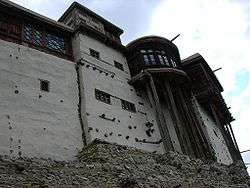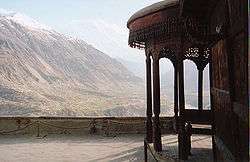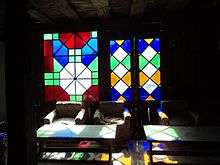Baltit Fort
| Baltit Fort | |
|---|---|
|
Baltit Fort east elevation | |
 Location within Pakistan | |
| General information | |
| Country | Gilgit-Baltistan, Pakistan |
| Coordinates | 36°19′32″N 74°40′11″E / 36.325556°N 74.669722°ECoordinates: 36°19′32″N 74°40′11″E / 36.325556°N 74.669722°E |
Baltit Fort is an ancient fort in the Hunza valley in Gilgit-Baltistan, Pakistan. Founded in the 1st CE, it has been on the UNESCO World Heritage Tentative list since 2004.[1]
In the past, the survival of the feudal regime of Hunza was ensured by the impressive fort, which overlooks Karimabad. The foundations of the fort date back to 700 years ago, with rebuilds and alterations over the centuries. In the 16th century the local prince married a princess from Baltistan who brought master Balti craftsmen to renovate the building as part of her dowry.
The Mirs of Hunza abandoned the fort in 1945, and moved to a new palace down the hill. The fort started to decay which caused concern that it might possibly fall into ruin. Following a survey by the Royal Geographical Society of London a restoration programme was initiated and supported by the Aga Khan Trust for Culture Historic Cities Support Programme. The programme was completed in 1996 and the fort is now a museum run by the Baltit Heritage Trust.
Historical background


In the past several small independent states formed part of the history of the Northern Areas of Pakistan. Among them Hunza and Nager were traditional rival states, situated on opposite sides of the Hunza (Kanjut) river. The rulers of these two states, Mirs known as Thum (also Tham, Thom or Thámo), built various strongholds to consolidate their power. According to historical sources,[2] the Hunza rulers initially resided in nearby Altit Fort, but after a conflict between the two sons of the ruler Sultan, Shah Abbas (Shάboos) and Ali Khan (Aliqhάn), Shaboos moved to Baltit Fort, making it the capital seat of Hunza. The power struggle between the two brothers eventually resulted in the death of younger one, and so Baltit Fort became the prime seat of power in the Hunza state.
Ayasho II, Thum/Mir of Hunza in the early 15th fifteenth century married Princess Shah Khatoon (Sha Qhatun) from Baltistan (in Moghul history Baltistan is called Tibet Khurd, which means Little Tibet), and was the first to modify the face of Altit and, subsequently Baltit Fort. Baltistan had a very strong cultural and ethnical relation with the Ladakh territory to the east. Not surprisingly, the structure of Baltit Fort was influenced by Ladakhi/Tibetan architecture, with some resemblance to the Potala Palace in Lhasa. Then additions, renovations and changes to the building were being made through the centuries by a long line of following rulers of Hunza.


Home of many ancient forts, the Northern Areas of Pakistan lost some of its heritage around the 19th century as a result of attacks by the Maharaja of Kashmir. However, one of the biggest changes in the structure of the Baltit Fort came with the invasion of the British in December 1891. Safdarali Khan, ruler of Hunza and his wazir Dadu (Thara Baig III), fled to befriended Kashgar (China) to seek 'political asylum' with their fellows and families. With the conquest of Hunza and Nager states the fortified wall and watch towers of the old Baltit village and watch towers of the Baltit Fort on its north-western end were demolished as required by the British. They installed his younger brother, Sir Muhammad Nazim Khan K.C.I.E, as the ruler of Hunza state in September 1892.[3]

During his reign, Nazeem Khan made several major alterations to the Baltit Fort. He demolished a number of rooms of third floor and added a few rooms in the British colonial style on the front elevation, using lime wash and colour glass panel windows.

Baltit Fort remained officially inhabited until 1945, when the last ruler of Hunza, Mir Muhammad Jamal Khan, moved to a new palatial house further down the hill, where the present Mir of Hunza, Mir Ghazanfar Ali Khan, and his family are still residing.
With no proper authority entrusted the Fort was exposed to the ravages of time and over the years its structure weakened and began to deteriorate. His Highness Aga Khan IV initiated the restoration efforts for Baltit Fort in 1990, when Mir Ghazanfar Ali Khan and his family generously transferred the Fort to the Baltit Heritage Trust, a public charity formed for the explicit purpose of owning and maintaining the Fort. The restoration undertaken by the Aga Khan Trust for Culture in Geneva in association with the Aga Khan Cultural Service Pakistan (Pakistan), took six years to complete. The project was supported by the Aga Khan Trust for Culture as the main donor through its Historic Cities Support Programme, as well as by the Getty Grant Program (USA), the Norwegian Agency for Development Cooperation and the French Government.
The restored Fort, resplendent in its formal regal glory, was inaugurated on September 29, 1996 in the presence of His Highness the Aga Khan IV and the president of Pakistan Farooq Ahmad Khan Laghari. It is now operated and maintained by the Baltit Heritage Trust and is open to visitors. The Baltit Fort serves as a good example of culture restored and preserved for future generations.
Awards and recognition
- 2005 Time Magazine Asia, Best of Asia Award[4]
- 2004 UNESCO Asia-Pacific Heritage Awards for Cultural Conservation - Award of Excellence (see profile)[5]
- 2000 Tourism for Tomorrow Awards: Global Winner[6][7]
Bibliography
- Baig Qudratullah, Tarikh-e-Edh Atiiq Riyāsat Hunza. S.T. Printers, Rawalpindi,Pakistan 1980.
- Dani A.H, History of Northern Areas of Pakistan. Sang-e-Meel Publications, Lahore Pakistan. www.sang-e-meel.com. Reprinted: 2007.
- Biddulph John, Tribes of Hindoo Koosh, The Superintendent of Government Printing-Calcutta, India 1880, Reprint: Ali Kamran Publishers, Lahore-Pakistan, 1995.
See also
References
- ↑ Baltit Fort UNESCO Tentative List - official website. Retrieved 05 October 2014.
- ↑ Tarikh-e-Ehd Atiiq Riyasat Hunza, Haji Qudrarullah Baig, S.T.Printers, Rawalpindi 1980, Pakistan
- ↑ History of Northern Areas of Pakistan by Prof. A.H.Dani, Page:285 Pub: Sang-e-Meel Publications, Lahore Pakistan www.sang-e-meel.com, Reprinted: 2007
- ↑ Baker, Aryn (2005-04-07). "Best of Asia: Baltit Fort Hunza Valley, INDIA - Time Asia, June 27, 2005". Retrieved 2006-12-11.
- ↑ "Baltit Fort Awarded Top Prize in the UNESCO 2004 Asia-Pacific Heritage Awards - UNESCO Bangkok, September 1, 2004" (PDF). Retrieved 2006-12-11.
- ↑ "BA Tourism for Tomorrow Previous Winners" (PDF). Archived from the original (PDF) on September 27, 2007. Retrieved 2006-12-11.
- ↑ "Restoration of Landmark Buildings in Mountainous Northern Pakistan - AKDN". Archived from the original on 6 December 2006. Retrieved 2006-12-11.
External links
| Wikimedia Commons has media related to Baltit Fort, Hunza-Nagar, Hunza valley. |
